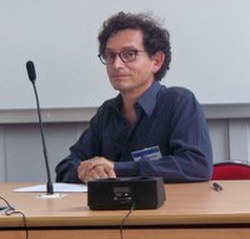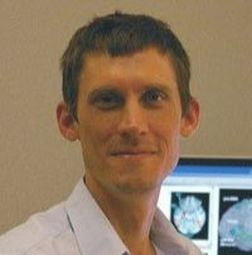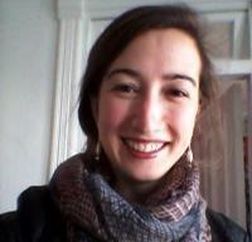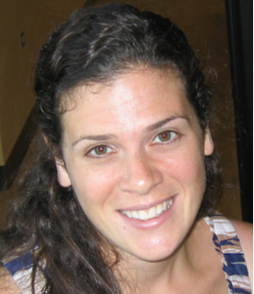Faculty

Raúl Aranovich
Raúl Aranovich is a theoretical linguist working on the interfaces between syntax, morphology, and semantics. His research focuses on grammatical mismatches between these levels. Professor Aranovich specializes in the grammars of Spanish and other romance languages, but also Fijian and Shona. He employs empirical methods using natural language processing and corpus linguistics tools, which recently have lead him to work on computer-mediated communication. He earned a Ph.D. in linguistics from UC San Diego in 1996, under the direction of Profs. S.-Y. Kuroda and John Moore. He has been at UC Davis since 2001, and is currently an associate professor. He held faculty positions at the Ohio State University and the University of Texas in San Antonio before joining UC Davis.
Raúl Aranovich is a theoretical linguist working on the interfaces between syntax, morphology, and semantics. His research focuses on grammatical mismatches between these levels. Professor Aranovich specializes in the grammars of Spanish and other romance languages, but also Fijian and Shona. He employs empirical methods using natural language processing and corpus linguistics tools, which recently have lead him to work on computer-mediated communication. He earned a Ph.D. in linguistics from UC San Diego in 1996, under the direction of Profs. S.-Y. Kuroda and John Moore. He has been at UC Davis since 2001, and is currently an associate professor. He held faculty positions at the Ohio State University and the University of Texas in San Antonio before joining UC Davis.

David Corina
My research explores the neurobiology and structure of language through comparisons of spoken and signed languages. This work includes understanding how neural systems which mediate language abilities adapt to sensory loss, sensory restoration, brain injury and recovery. Current projects include developmental studies of language and cognitive processing in deaf children with cochlear implants, psycholinguistic studies of spoken and signed language processing and sign language aphasia.
Lab website
My research explores the neurobiology and structure of language through comparisons of spoken and signed languages. This work includes understanding how neural systems which mediate language abilities adapt to sensory loss, sensory restoration, brain injury and recovery. Current projects include developmental studies of language and cognitive processing in deaf children with cochlear implants, psycholinguistic studies of spoken and signed language processing and sign language aphasia.
Lab website

Fernanda Ferreira
Professor Ferreira’s area of research is psycholinguistics. She uses basic insights from formal linguistics, especially theories in sentence phonology and syntax, to develop models of processing. Her empirical work relies both on behavioral and neural measures, including eyetracking (for measurement of fixations, saccades and pupil diameter) and the recording of event-related potentials (ERPs). The fundamental aim of her research is to uncover the mechanisms that enable humans to understand and generate language in real time and in cooperation with other cognitive systems.
Lab website
Professor Ferreira’s area of research is psycholinguistics. She uses basic insights from formal linguistics, especially theories in sentence phonology and syntax, to develop models of processing. Her empirical work relies both on behavioral and neural measures, including eyetracking (for measurement of fixations, saccades and pupil diameter) and the recording of event-related potentials (ERPs). The fundamental aim of her research is to uncover the mechanisms that enable humans to understand and generate language in real time and in cooperation with other cognitive systems.
Lab website

Katharine Graf-Estes
Infants are immersed in a world of immense complexity, yet they display knowledge of the people, objects, actions, and sounds in their environments very early in life. Professor Graf Estes’ research explores the mechanisms that support this early learning. In particular, the ability to detect statistical regularities may play a fundamental role in how infants learn about a highly complex, highly salient aspect of the auditory world: language. Infants become especially attuned to regularities in the sound patterns of the ambient language, including its phoneme distinctions, sound combinations within words, and its cues to word boundaries in fluent speech. Thus, when infants begin to understand and produce words, they do not start as blank slates. She investigates how infants learn from statistical regularities in the language they hear and the nature of what they learn.
Lab website
Infants are immersed in a world of immense complexity, yet they display knowledge of the people, objects, actions, and sounds in their environments very early in life. Professor Graf Estes’ research explores the mechanisms that support this early learning. In particular, the ability to detect statistical regularities may play a fundamental role in how infants learn about a highly complex, highly salient aspect of the auditory world: language. Infants become especially attuned to regularities in the sound patterns of the ambient language, including its phoneme distinctions, sound combinations within words, and its cues to word boundaries in fluent speech. Thus, when infants begin to understand and produce words, they do not start as blank slates. She investigates how infants learn from statistical regularities in the language they hear and the nature of what they learn.
Lab website

John Hawkins
Professor Hawkins has a broad and interdisciplinary interests in the language sciences. His current research programs focus on language universals from a processing perspective, on second language acquisition using electronic learner corpora, and on English and the Germanic language family. In his 2004 book, Efficiency and Complexity in Grammars (Oxford University Press), he presented extensive empirical evidence for the view that principles of language processing derived from experimental and corpus studies on individual languages can be extended to account for grammatical universals and variation patterns across languages. An updating of this research program can be found in his forthcoming book, Cross-linguistic Variation and Efficiency (Oxford University Press). His 2012 book, Criterial Features in L2 English (with Luna Filipović, Cambridge University Press) presents his current ideas on second language learning.
Link to publications
Professor Hawkins has a broad and interdisciplinary interests in the language sciences. His current research programs focus on language universals from a processing perspective, on second language acquisition using electronic learner corpora, and on English and the Germanic language family. In his 2004 book, Efficiency and Complexity in Grammars (Oxford University Press), he presented extensive empirical evidence for the view that principles of language processing derived from experimental and corpus studies on individual languages can be extended to account for grammatical universals and variation patterns across languages. An updating of this research program can be found in his forthcoming book, Cross-linguistic Variation and Efficiency (Oxford University Press). His 2012 book, Criterial Features in L2 English (with Luna Filipović, Cambridge University Press) presents his current ideas on second language learning.
Link to publications

John Henderson
Professor Henderson has broad interests in human cognition. In the area of language, he focuses especially on reading. He is currently studying lexical processing during reading, the role of language prediction in reading, and how individual differences in cognitive processes lead to individual differences in reading ability. He is also interested in how visual and linguistic representations are integrated. To study these topics, he uses eyetracking, neuroimaging, and computational methods. Much of this work combines eyetracking and neuroimaging to conduct Fixation-Related (FIRE) fMRI.
Lab website
Professor Henderson has broad interests in human cognition. In the area of language, he focuses especially on reading. He is currently studying lexical processing during reading, the role of language prediction in reading, and how individual differences in cognitive processes lead to individual differences in reading ability. He is also interested in how visual and linguistic representations are integrated. To study these topics, he uses eyetracking, neuroimaging, and computational methods. Much of this work combines eyetracking and neuroimaging to conduct Fixation-Related (FIRE) fMRI.
Lab website

Debra Long
The goal of my research is to understand the nature of language comprehension. How do readers/listeners integrate new, incoming information into their developing discourse representations? What linguistic skills and cognitive abilities are necessary to create integrated mental representations of described events? What is the role of basic cognitive processes (e.g., attention, memory retrieval) in discourse comprehension? I use multiple methods in my research, including behavioral, individual-difference, neuropsychological, and electrophysiological approaches.
The goal of my research is to understand the nature of language comprehension. How do readers/listeners integrate new, incoming information into their developing discourse representations? What linguistic skills and cognitive abilities are necessary to create integrated mental representations of described events? What is the role of basic cognitive processes (e.g., attention, memory retrieval) in discourse comprehension? I use multiple methods in my research, including behavioral, individual-difference, neuropsychological, and electrophysiological approaches.

Lee Miller
Professor Miller is dedicated to understanding the neural bases of auditory perception and speech recognition in human listeners. His methods include non-invasive techniques such as functional magnetic resonance imaging (fMRI), high-density electroencephalography (EEG), and neural network analysis. He learns how different parts of the brain cooperate to achieve perception - especially in noisy environments - and what happens when comprehension fails.
Lab website
Professor Miller is dedicated to understanding the neural bases of auditory perception and speech recognition in human listeners. His methods include non-invasive techniques such as functional magnetic resonance imaging (fMRI), high-density electroencephalography (EEG), and neural network analysis. He learns how different parts of the brain cooperate to achieve perception - especially in noisy environments - and what happens when comprehension fails.
Lab website

Emily Morgan (arriving summer 2018)
My research asks the form of stored representations and how the language processing system integrates them with incoming stimuli to form online expectations during language comprehension. For example, when one encounters a highly frequent phrase such as “bread and butter”, is this phrase represented and processed holistically as a single unit, or compositionally as a conjunction of nouns? Is the form of this representation influenced by the frequency of the expression (compared to a less frequent expression like “facts and techniques”) or its frozenness in a given order (compared to a more flexible expression like “boys and girls”/”girls and boys”)? To answer these questions, I combine experimental psycho- and neurolinguistic methods, such as eye-tracking and ERPs, with probabilistic computational modeling.
Website
My research asks the form of stored representations and how the language processing system integrates them with incoming stimuli to form online expectations during language comprehension. For example, when one encounters a highly frequent phrase such as “bread and butter”, is this phrase represented and processed holistically as a single unit, or compositionally as a conjunction of nouns? Is the form of this representation influenced by the frequency of the expression (compared to a less frequent expression like “facts and techniques”) or its frozenness in a given order (compared to a more flexible expression like “boys and girls”/”girls and boys”)? To answer these questions, I combine experimental psycho- and neurolinguistic methods, such as eye-tracking and ERPs, with probabilistic computational modeling.
Website

Vai Ramanathan
I am an applied sociolinguist and my research interests span two broad domains: Language and the Body (which includes language and memory) and Language Policy (which includes first and second language development, and literacy and orthographic development).
Webpage
I am an applied sociolinguist and my research interests span two broad domains: Language and the Body (which includes language and memory) and Language Policy (which includes first and second language development, and literacy and orthographic development).
Webpage

Kenji Sagae
Much of my research has been focused on data-driven and linguistically-motivated models of structure in natural language. Topics in my current and past work include: Syntactic parsing, analysis of child language, incremental processing, interfacing shallow and deep syntactic analysis, parser ensembles, discriminative structured models, parsing efficiency, and descriptive adequacy of syntactic formalisms. I have applied this research various areas including child language development, bioinformatics and virtual human dialogue systems.
Webpage
Much of my research has been focused on data-driven and linguistically-motivated models of structure in natural language. Topics in my current and past work include: Syntactic parsing, analysis of child language, incremental processing, interfacing shallow and deep syntactic analysis, parser ensembles, discriminative structured models, parsing efficiency, and descriptive adequacy of syntactic formalisms. I have applied this research various areas including child language development, bioinformatics and virtual human dialogue systems.
Webpage

Claudia Sánchez-Gutiérrez
My research focuses on second language acquisition, textbook analysis, frequency effects in vocabulary learning, and derivational morphology in second language teaching
Webpage
My research focuses on second language acquisition, textbook analysis, frequency effects in vocabulary learning, and derivational morphology in second language teaching
Webpage

Tamara Swaab
Research in the Laboratory for the Cognitive Neuroscience of Language focuses on the psychological and neural mechanisms of language comprehension in young and older adults. We also model individual differences in language processing as a function of measures of cognitive control, working memory, perceptual speed and language experience. Finally, we examine how language processing mechanisms break down in patients with circumscribed lesions and in individuals with neuropsychiatric disorders such as schizophrenia. We use multiple research methods to gain the deepest possible understanding of the psychological processes and brain mechanisms that we use to extract meaning from text and conversation, and include eyetracking (collaboratively), the recording of brain electrical activity (EEG/ERP) and hemodynamic responses (functional magnetic resonance imaging — fMRI), as well as a variety of other behavioral measures.
Webpage
Research in the Laboratory for the Cognitive Neuroscience of Language focuses on the psychological and neural mechanisms of language comprehension in young and older adults. We also model individual differences in language processing as a function of measures of cognitive control, working memory, perceptual speed and language experience. Finally, we examine how language processing mechanisms break down in patients with circumscribed lesions and in individuals with neuropsychiatric disorders such as schizophrenia. We use multiple research methods to gain the deepest possible understanding of the psychological processes and brain mechanisms that we use to extract meaning from text and conversation, and include eyetracking (collaboratively), the recording of brain electrical activity (EEG/ERP) and hemodynamic responses (functional magnetic resonance imaging — fMRI), as well as a variety of other behavioral measures.
Webpage

Matthew Traxler
Matt mostly uses eye-tracking and ERPs to test cognitive accounts of language processing and interpretation. His research collaborations focus on language comprehension and individual differences. This experimental work tests how context, sentence properties, and individual characteristics (such as language experience, working memory, executive function) interact to affect on-line processing, comprehension, and memory for text. This work involves normal adults, deaf people, and patients with schizophrenia.
Webpage
Matt mostly uses eye-tracking and ERPs to test cognitive accounts of language processing and interpretation. His research collaborations focus on language comprehension and individual differences. This experimental work tests how context, sentence properties, and individual characteristics (such as language experience, working memory, executive function) interact to affect on-line processing, comprehension, and memory for text. This work involves normal adults, deaf people, and patients with schizophrenia.
Webpage

Georgia Zellou
Georgia Zellou’s research focus is in the areas of phonetics, speech perception, and laboratory phonology. Her research program focuses on understanding how phonetic detail is represented by the cognitive system through the study of variations in fine-grained pronunciations of speech sounds. Her questions aim to address how phonetic & phonological patterns are abstracted, evolve and are used, functionally and pragmatically, in language communication.
Lab website